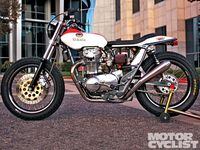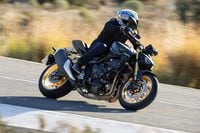There are two things you should know about Mule motorcycles. They're not cheap-Yamaha street-trackers like this one start at $23,000-and building one takes at least eight months. Mule founder, designer, fabricator and engine builder Richard Pollock is an incurable perfectionist. This one rolled out of the shop two years after Pollock's friend Gabe Slatton ordered it.
"Most guys who call me have seen my stuff on the interweb (see Mule Motorcycles) so we start out on the same page," says Pollock. "During the day, I work in the aerospace business, where everything is done by the rules." Inside Pollock's tiny San Diego shop, there is only one rule: no cutting corners.
Starting with a '77 Yamaha XS650 engine, Pollock added a JE 750cc big-bore kit along with a Shell cam and R/D valve springs. An '81 Yamaha electronic ignition lights combustibles from 34mm Mikuni carbs. The result puts about 60 horsepower on the pavement at 6000 rpm. Major surgery on a stock XS650 skeleton only left the backbone and swingarm pivot. Everything else is pure Pollock, finished with metallic-gray powder-coat and a layer of clear. No cutting corners, remember?
The rest is an eclectic mix, starting with a powder-coated XS650 front hub and a H-D Sportster rear, laced to Sun rims. Brake rotors came from a Ducati 900SS; fork legs and brake calipers from a Yamaha FZR1000. Billet triple-clamps are Pollock's. The Champion-style seat comes from First Klass Glass, and the fuel tank is a massaged '75 Yamaha MX250 bit. Tony at Uptown Cycle Design in San Diego did the paint.
At 340 pounds, number three of eight XS750 Mules is 100 lbs. lighter than Yamaha's original 1970 XS-1 and 1000 times cooler. But is it really worth all that time and money? If another look doesn't answer that question, you wouldn't understand.

/cloudfront-us-east-1.images.arcpublishing.com/octane/GX2CIZKQVRH2TATDM26KFG2DAE.jpg)
/cloudfront-us-east-1.images.arcpublishing.com/octane/ZWIDYSAKQZHD5BHREMQILXJCGM.jpg)
/cloudfront-us-east-1.images.arcpublishing.com/octane/CYUHJZCTSJCH3MRAQEIKXK7SCQ.jpg)
/cloudfront-us-east-1.images.arcpublishing.com/octane/LKOFINY56FCXJCANJ5M7ZDQUBY.jpg)
/cloudfront-us-east-1.images.arcpublishing.com/octane/4NBPDACMWJH63JQYJVK3QRBDZI.jpg)
/cloudfront-us-east-1.images.arcpublishing.com/octane/KKHQHRR3FJGX7H2IPU6RALMWG4.jpg)

/cloudfront-us-east-1.images.arcpublishing.com/octane/5IOFS5JAE5FOXMNA23ZRAVVYUU.jpg)
/cloudfront-us-east-1.images.arcpublishing.com/octane/CGXQ3O2VVJF7PGTYR3QICTLDLM.jpg)

/cloudfront-us-east-1.images.arcpublishing.com/octane/OQVCJOABCFC5NBEF2KIGRCV3XA.jpg)
/cloudfront-us-east-1.images.arcpublishing.com/octane/OPVQ7R4EFNCLRDPSQT4FBZCS2A.jpg)
/cloudfront-us-east-1.images.arcpublishing.com/octane/YBPFZBTAS5FJJBKOWC57QGEFDM.jpg)
/cloudfront-us-east-1.images.arcpublishing.com/octane/W5DVCJVUQVHZTN2DNYLI2UYW5U.jpg)
/cloudfront-us-east-1.images.arcpublishing.com/octane/C3VIRIAYNZCTJAZNRLREDS3JCM.jpg)
/cloudfront-us-east-1.images.arcpublishing.com/octane/XXWKUKITWRAF3HCJAWGJ25V7BA.jpg)
/cloudfront-us-east-1.images.arcpublishing.com/octane/MALB2TULBRCQJJ3P3UXMU2N7QE.jpg)
/cloudfront-us-east-1.images.arcpublishing.com/octane/B6KMLYR3T5GMNA7F7URZVLO72I.jpg)
/cloudfront-us-east-1.images.arcpublishing.com/octane/RIBH2PB5DBFEZFEYXDOD5Z6ECA.JPG)
/cloudfront-us-east-1.images.arcpublishing.com/octane/FY7HQZFIM5CYVAKOLBQ5F7BWZU.JPG)
/cloudfront-us-east-1.images.arcpublishing.com/octane/YGET42VCYRCEBOLKHTHFQGH72A.jpg)
/cloudfront-us-east-1.images.arcpublishing.com/octane/YLPY3KQYRVD2JG3RJMEQB4574A.jpg)
/cloudfront-us-east-1.images.arcpublishing.com/octane/RDF24VM7WVCOBPIR3V3R4KS63U.jpg)
/cloudfront-us-east-1.images.arcpublishing.com/octane/WQ2LIEL7RFBXFATR5LA6GOSRXE.jpg)